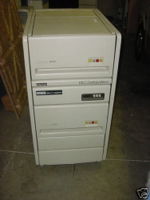Difference between revisions of "PDP-11/03"
(→External links: +options) |
(Thumnail of /03's major points) |
||
| Line 8: | Line 8: | ||
[[Image:Pdp11-03.JPG|150px|right|thumb|PDP-11/03]] | [[Image:Pdp11-03.JPG|150px|right|thumb|PDP-11/03]] | ||
| + | |||
| + | The '''PDP-11/03''', which initially shipped with the new [[LSI-11]] [[Central Processing Unit|CPU]], marked a major change in the [[PDP-11]] family in two ways: | ||
| + | |||
| + | * it was the first PDP-11 to essentially use a [[microprocessor]] (although the [[LSI-11 chip set]] was 4 [[integrated circuit|chips]], not 1, it was effectively a microprocessor); | ||
| + | * it was the first to use a new system [[bus]], the [[QBUS]], which used fewer [[conductor|lines]] (thus allowing [[printed circuit board|cards]] which plugged into QBUS [[backplane]]s to have fewer contact fingers), thereby reducing costs. | ||
== hampage.hu == | == hampage.hu == | ||
Quoting: | Quoting: | ||
| − | : ''1975. With the use of LSI semiconductor technology (the [[LSI-11]] and [[LSI-11/2]] processor), it was a compact implementation of the -11 architecture. It was limited though, to 32KW memory, only one processor operating mode, and limited floating-point instructions. Available options: CIS, WCS, EIS/FIS.'' | + | : ''1975. With the use of LSI semiconductor technology (the [[LSI-11]] and [[LSI-11/2]] processor), it was a compact implementation of the -11 architecture. It was limited though, to 32KW memory, only one processor operating mode, and limited floating-point instructions (the [[FIS floating point|FIS]]). Available options: CIS, WCS, EIS/FIS.'' |
| − | : ''The /03 used the new LSI bus, later known as the [[QBUS]], and was aimed at the low-end market, as the successor of the /05. | + | : ''The /03 used the new LSI bus, later known as the [[QBUS]], and was aimed at the low-end market, as the successor of the /05. The slowest of the -11s (one third of the 11/20's performance).'' |
| − | A PDP-11/03 was also used as the [[diagnostic]] and control unit for the [[VAX-11/780]]'s | + | A PDP-11/03 was also used as the [[diagnostic]] and control unit for the [[VAX-11/780]]'s CPU; it would [[bootstrap]] the system. |
{{semi-stub}} | {{semi-stub}} | ||
Revision as of 10:52, 24 December 2021
| PDP-11/03 | |
| Manufacturer: | Digital Equipment Corporation |
|---|---|
| Architecture: | PDP-11 |
| Year Introduced: | 1975 |
| Bus Architecture: | QBUS |
The PDP-11/03, which initially shipped with the new LSI-11 CPU, marked a major change in the PDP-11 family in two ways:
- it was the first PDP-11 to essentially use a microprocessor (although the LSI-11 chip set was 4 chips, not 1, it was effectively a microprocessor);
- it was the first to use a new system bus, the QBUS, which used fewer lines (thus allowing cards which plugged into QBUS backplanes to have fewer contact fingers), thereby reducing costs.
hampage.hu
Quoting:
- 1975. With the use of LSI semiconductor technology (the LSI-11 and LSI-11/2 processor), it was a compact implementation of the -11 architecture. It was limited though, to 32KW memory, only one processor operating mode, and limited floating-point instructions (the FIS). Available options: CIS, WCS, EIS/FIS.
- The /03 used the new LSI bus, later known as the QBUS, and was aimed at the low-end market, as the successor of the /05. The slowest of the -11s (one third of the 11/20's performance).
A PDP-11/03 was also used as the diagnostic and control unit for the VAX-11/780's CPU; it would bootstrap the system.
External links
| v • d • e PDP-11 Computers and Peripherals |
|---|
| UNIBUS PDP-11s - PDP-11/20 • PDP-11/15 • PDP-11/35 • PDP-11/40 • PDP-11/45 • PDP-11/50 • PDP-11/55 • PDP-11/70 PDP-11/05 • PDP-11/10 • PDP-11/04 • PDP-11/34 • PDP-11/60 • PDP-11/44 • PDP-11/24 • PDP-11/84 • PDP-11/94 QBUS PDP-11s - PDP-11/03 • PDP-11/23 • PDP-11/23+ • MicroPDP-11/73 • MicroPDP-11/53 • MicroPDP-11/83 • MicroPDP-11/93 QBUS CPUs: LSI-11 • LSI-11/2 • KDF11-A • KDF11-B • KDJ11-A • KDJ11-B • KDJ11-D • KDJ11-E Buses: UNIBUS • UNIBUS map • SPC • MUD • EUB • QBUS • CD interconnect • PMI Also: PDP-11 architecture • PDP-11 Extended Instruction Set • FP11 floating point • PDP-11 Memory Management |
| UNIBUS CPUs: KA11 • KC11 • KB11-A • KB11-B • KB11-C • KB11-D • KD11-A • KD11-B • KD11-D • KD11-E • KD11-EA • KD11-K • KD11-Z • KDF11-U
Co-processors: FP11-A • FP11-B • FP11-C • FP11-E • FP11-F • KE44-A • FPF11 Chips: LSI-11 • KEV11-A • KEV11-B • KEV11-C • F-11 • KEF11-A • KTF11-A • T-11 • J-11 • FPJ11 CPU options: KE11-E • KE11-F • KJ11-A • KT11-C • KT11-D • KK11-A • KK11-B • KT24 • KTJ11-B Rare CPU options: KS11 Memory Protection and Relocation option • KT11-B Paging Option • KUV11 Writeable Control Store Front panels: KY11-A • KY11-D • KY11-J • KY11-LA • KY11-LB • KY11-P More on buses: UNIBUS and QBUS termination • Bus Arbitration on the Unibus and QBUS • CTI BUS PDT-11s - PDT-11/110 • PDT-11/130 • PDT-11/150 CTI PDP-11s - PRO-325 • PRO-350 • PRO-380 Other: FIS floating point • PDP-11 Commercial Instruction Set • PDP-11 stacks • PDP-11 family differences |
